2017 Annual Merit Review Awards
Each year, at the Annual Merit Review and Peer Evaluation Meeting, the Hydrogen and Fuel Cells Program presents awards for contributions to the overall efforts of the Program and to recognize achievements in specific areas.
Joint Fuel Cell Technologies and Vehicle Technologies Office Award
Scott Jorgensen, General Motors
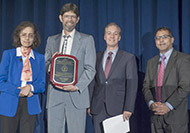
L to R: Sunita Satyapal, Fuel Cell Technologies Office (FCTO); Scott Jorgensen, GM; Michael Berube, Vehicle Technologies Office (VTO); Reuben Sarkar, Office of Energy Efficiency & Renewable Energy (EERE).
This award recognizes Scott Jorgensen for outstanding technical leadership in support of DOE's hydrogen and fuel cell research and development (R&D), electric vehicle battery R&D, and the United States Advanced Battery Consortium's (USABC's) Technical Advisory Committee. Scott has been a technical lead at General Motors since 1985, and has been working with DOE's Hydrogen and Fuel Cell Technologies and Vehicle Technologies Programs for more than 20 years. He has been a key contributing member to several of the technical teams formed to review and evaluate R&D conducted by partners in the U.S. DRIVE (United States Driving Research and Innovation for Vehicle efficiency and Energy sustainability) government-industry partnership. He participated in the U.S. DRIVE Fuel Cell and Hydrogen Storage Tech Teams for many years before coming to the Electrochemical Energy Storage Tech Team to help USABC advance battery technology for use in many applications. Over the past seven years, Scott has worked with the USABC Technical Advisory Committee to help manage multiple battery development contracts, including those for LG Chem, Amprius, Envia Systems, Saft America, Maxwell Technologies, and many others. He also served on numerous USABC workgroups helping to develop requirements, test procedures, requests for proposals, and proposal selections. He successfully guided the Maxwell 12V start-stop hybrid battery/supercapacitor development program, eventually leading to the Maxwell Ultracap Engine Start Module (ESM) as a factory-installed option on new Kenworth T680 and T880 trucks in 2013, and in September 2015, GM announced that they would use Maxwell's ultracapacitors in its voltage stabilization system
Hydrogen and Fuel Cells Program Awards
Aaron Harris, Air Liquide

L to R: Sunita Satyapal, FCTO; Aaron Harris, Air Liquide; Reuben Sarkar, EERE.
Chris LaFleur, Sandia National Laboratories

L to R: Will James, FCTO; Chris LaFleur, SNL; Laura Hill, FCTO.
This award recognizes Chris LaFleur of Sandia National Laboratories for her outstanding leadership and continued dedication to hydrogen safety and the application of hydrogen behavior and risk assessment. As a risk expert, Chris has been key to NFPA 2, where her work has shaped national fire codes that reduce barriers to commercial use of energy. She has provided essential support in New England to help cities in the region understand and manage potential risks to their tunnel systems for advancing the use of hydrogen in transportation. Chris's expertise has also been a valuable asset to the activities of the Hydrogen Safety Panel, where she has served as a member since 2015.
Charlie Myers, CSRA
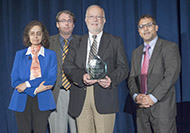
L to R: Sunita Satyapal, FCTO; Pete Devlin, FCTO; Charlie Myers, CSRA; Reuben Sarkar, EERE.
This award recognizes Charlie Myers for his continued commitment to the advancement of hydrogen and fuel cell technologies in the Northeast region. Charlie consistently exhibits exemplary dedication, creativity, and collaboration in all of his many responsibilities. Some of Charlie's accomplishments this year include organizing and facilitating three successful hydrogen infrastructure investor briefings; assisting the Massachusetts Department of Energy Resources in developing fuel cell vehicle and hydrogen infrastructure incentive programs and identifying state-funded hydrogen refueling stations siting activities; supporting tunnel studies in Boston and New York City using his in-depth compressed natural gas knowledge and experiences; and helping identify available surplus government property to host project demonstrations.
Hydrogen Production and Delivery
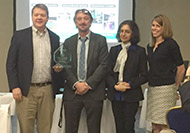
L to R: Todd Deutsch, NREL; Eric Miller, FCTO; Sunita Satyapal, FCTO; Katie Randolph, FCTO (Not pictured: James Young and Myles Steiner.)
Todd Deutsch, James Young, and Myles Steiner, National Renewable Energy Laboratory
This award recognizes the National Renewable Energy Laboratory 's (NREL's) photoelectrochemical (PEC) research team, including Todd Deutsch, James Young, and Myles Steiner, for their outstanding scientific achievement—a new world record in solar-to-hydrogen (STH) conversion efficiency in their innovative PEC device structure. Building on NREL's previous PEC record of 12.8% STH conversion efficiency established in the 1990s, the team implemented state-of-the-art innovations in materials synthesis and surface engineering to optimize performance, achieving the new world record of 16.2% STH conversion efficiency. This important accomplishment is recognized in their 2017 peer-reviewed article published in the prestigious Nature Energy journal.
Hydrogen Storage
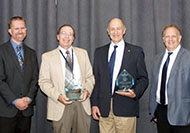
L to R: Jesse Adams, FCTO; Theodore Motyka, Greenway Energy; Donald Anton, SRNL; Ned Stetson, FCTO.
Donald Anton, Savannah River National Laboratory, and Theodore Motyka, Greenway Energy (retired from Savannah River National Laboratory)
This award recognizes Donald Anton of Savannah River National Laboratory and Theodore Motyka, now with Greenway Energy, for their dedicated leadership of the highly successful and collaborative Hydrogen Storage Engineering Center of Excellence (HSECoE), from 2009 through 2016. The HSECoE consisted of more than 10 partners, including participants from industry, universities, and national laboratories. Through the development of complete validated system models, the HSECoE was able to establish a baseline for current state-of-the-art materials-based hydrogen storage systems. The developed models are now available and are being used by researchers from around the world. These models are also being applied and leveraged for the design and evaluation of systems for non-automotive applications. This effort has allowed, through reverse engineering, for the determination of material-level performance specifications needed to meet the Hydrogen Storage onboard system performance targets.
Fuel Cells
Michael Yandrasits, 3M
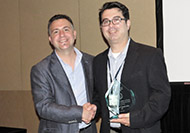
L to R: Dimitrios Papageorgopoulos, FCTO; Michael Yandrasits, 3M.
This award recognizes Michael Yandrasits from 3M for his outstanding work on proton exchange membrane fuel cell membranes. He is the team leader for 3M's supported membrane development and has been at 3M for 25 years, with the last 15 years in the Fuel Cell Components Program. He has been relentless in the development of a membrane that combines a novel multi-acid side chain ionomer with an improved nanofiber support. The membrane simultaneously meets nearly all of DOE's 2020 membrane targets, exhibiting excellent fuel cell performance under hotter and dryer conditions. Michael is also proactively engaged in the U.S. DRIVE-government-industry partnership's efforts to improve membrane testing protocols.
Anusorn Kongkanand, General Motors

L to R: Dimitrios Papageorgopoulos, FCTO; Anusorn Kongkanand, GM.
This award recognizes Anusorn Kongkanand from General Motors (GM) for his outstanding work on proton exchange membrane fuel cell catalysts. He has been at GM for 10 years, currently directing GM's efforts on advanced catalysts. He has consistently been on the leading edge in his field, with 18 approved or pending patents and more than 40 published articles and reviews in the area of energy conversion devices, which have accumulated more than 3,000 citations. Anusorn developed a highly accessible low platinum group metal catalyst that exceeds DOE's 2020 performance targets. This achievement was accomplished using a dealloyed platinum/cobalt (Pt/Co) catalyst on high surface area carbon support to significantly improve performance at high current densities by reducing the local transport resistance in high surface area carbon micropores. Incorporating the Pt/Co catalyst developed by Anusorn and his team into the DOE's 2017 Fuel Cell Cost Analysis led to a reduction in fuel cell systems costs by $.50/kW.
Manufacturing R&D
Patrick Fullenkamp, GLWN
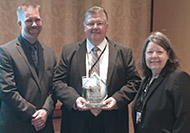
L to R: Jesse Adams, FCTO; Patrick Fullenkamp, GLWN; Nancy Garland, FCTO.
This award recognizes Patrick Fullenkamp of GLWN who, with his international team, carried out a comprehensive examination of current and projected costs of hydrogen and fuel cell components and systems. GLWN also examined supply chains using feedback from original equipment manufacturers (OEMs) and suppliers as well as assessments of global trade flow evolution. Patrick and his team employed cost breakdown analysis and value stream mapping as well as in-person interviews to gather key industry information that enabled OEMs and suppliers to provide directional and discrete information on the DOE cost model, technical and manufacturing readiness, current and future manufacturing process assumptions, and future developments required to meet the needs of this industry at high and low manufacturing volumes.
Safety, Codes, and Standards
Mike Steele, Steele Consulting

L to R: Sunita Satyapal, FCTO; Mike Steele, Steele Consulting.
This award recognizes Mike Steele for his outstanding leadership and commitment to the development of domestic and international regulations, codes, and standards essential to the deployment of fuel cell electric vehicles. Mike joined SAE International in 1998 while an engineer at General Motors. He joined the Fuel Cell Vehicle (FCV) committee at SAE in 2000, and the Emissions, Performance, Interface and Safety working groups in 2003 and 2004. In 2007, he was elected to be chair of the SAE FCV Committee, a position he still holds. In the international community, Mike serves as a member of the International Organization for Standardization (ISO) TC22/SC37 Committee for electrically propelled vehicles and the International Electrotechnical Commission (IEC) TC 69 Committee for electric power train components. He has been lauded by his colleagues for his leadership skills, both technical and interpersonal, in these roles. His exceptional leadership has enabled the development of critical regulations, codes, and standards in support of the deployment of hydrogen technologies.
Technology Validation
Kevin Lee, Hyundai America Technical Center, Inc.
This award recognizes Kevin Lee of Hyundai for his outstanding contributions to the Technology Validation Program on fuel cell electric vehicle durability and hydrogen fueling stations. From the initial proposal and throughout the project, Kevin's team has continuously exceeded expectations in the performance of his durability assessment fleet, surpassing the number of vehicles on the road and mileage accumulation targets, despite delays and down-time of hydrogen stations in the early stages of introduction. In addition to providing performance data for a fleet of Hyundai's Tucson Fuel Cell, Kevin has been instrumental in providing loaner vehicles to both DOE and NREL, has facilitated the commissioning of hydrogen stations (including a station in Washington, D.C.), and has been a dedicated supporter of performance validation efforts of hydrogen fueling stations across the country.
